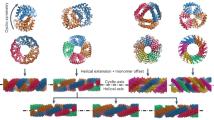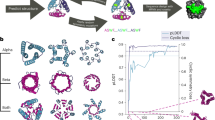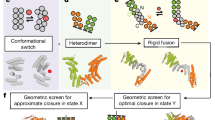Abstract
Controversy remains about the role of core side-chain packing in specifying protein structure. To investigate the influence of core packing on the oligomeric structure of a coiled coil, we engineered a GCN4 leucine zipper mutant that switches from two to three strands upon binding the hydrophobic ligands cyclohexane and benzene. In solution these ligands increased the apparent thermal stability and the oligomerization order of the mutant leucine zipper. The crystal structure of the peptide–benzene complex shows a single benzene molecule bound at the engineered site in the core of the trimer. These results indicate that coiled coils are well-suited to function as molecular switches and emphasize that core packing is an important determinant of oligomerization specificity.
This is a preview of subscription content, access via your institution
Access options
Subscribe to this journal
Receive 12 print issues and online access
$259.00 per year
only $21.58 per issue
Buy this article
- Purchase on SpringerLink
- Instant access to full article PDF
Prices may be subject to local taxes which are calculated during checkout
Similar content being viewed by others
References
Bryson, J.W. et al. Protein design: A hierarchic approach. Science 270, 935–941 (1995).
Spencer, D.M., Wandless, T.J., Schreiber, S.L. & Crabtree, G.R. Controlling signal transduction with synthetic ligands. Science 262, 1019–1024 (1993).
Landschulz, W.H., Johnson, P.F. & McKnight, S.L. The leucine zipper: a hypothetical structure common to a new class of DNA binding proteins. Science 240, 1759–1764 (1988).
Peteranderl, R. & Nelson, H.C.M. Trimerization of the heat shock transcription factor by a triple-stranded alpha-helical coiled-coil. Biochemistry 31, 12272–12276 (1992).
Parry, D.A.D. & Steinert, P.M. Intermediate filament structure. Curr. Opin. Cell Biol. 4, 94–98 (1992).
Hunter, I., Schulthess, T. & Engel, J. Laminin chain assembly by triple and double stranded coiled-coil structures. J. Biol. Chem. 267, 6006–6011 (1992).
Kodama, T. et al. Type I macrophage scavenger receptor contains alpha-helical and collagen-like coiled coils. Nature 343, 531–535 (1990).
Doi, T. et al. The histidine interruption of an alpha-helical coiled coil allosterically mediates a pH-dependent ligand dissociation from macrophage scavenger receptors. J. Biol. Chem. 269, 25598–25604 (1994).
Carr, C.M. & Kim, P.S. A spring-loaded mechanism for the conformational change of influenza hemagglutinin. Cell 73, 823–832 (1993).
Bullough, P.A., Hughson, F.M., Skehel, J.J. & Wiley, D.C. Structure of influenza haemagglutinin at the pH of membrane fusion. Nature 371, 37–43 (1994).
Rabindran, S.K., Haroun, R.I., Clos, J., Wisniewski, J. & Wu, C. Regulation of heat shock factor trimer formation: role of a conserved leucine zipper. Science 259, 230–234 (1993).
Oas, T.G. & Endow, S.A. Springs and hinges: dynamic coiled coils and discontinuities. Trends Biochem. Sci. 19, 51–54 (1994)
Cohen, C. & Parry, D.A.D. Alpha-helical coiled coils and bundles: how to design an alpha-helical protein. Proteins 7, 1–15 (1990).
Harbury, P.B., Kim, P.S. & Alber, T. Crystal structure of an isoleucine-zipper trimer. Nature 371, 80–83 (1994).
Cohen, C. & Parry, D.A.D. Alpha-helical coiled coils: more facts and better predictions. Science 263, 488–489 (1994).
Harbury, P.B., Zhang, T., Kim, P.S. & Alber, T. A switch between two-, three-, and four-stranded coiled coils in GCN4 leucine zipper mutants. Science 262, 1401–1407 (1993).
Zhu, B.Y., Zhou, N.E., Kay, C.M. & Hodges, R.S. Packing and hydrophobicity effects on protein folding and stability: effects of beta-branched amino acids, valine and isoleucine, on the formation and stability of two-stranded alpha-helical coiled coils/leucine zippers. Protein Science 2, 383–394 (1993).
Woolfson, D.N. & Alber, T. Predicting oligomerization states of coiled coils. Protein Science 4, 1596–1607 (1995).
O'Shea, E.K., Rutkowski, R. & Kim, P.S. Evidence that the leucine zipper is a coiled coil. Science 243, 538–542 (1989).
O'Shea, E.K., Klemm, J.D., Kim, P.S. & Alber, T. X-ray structure of the GCN4 leucine zipper, a two-stranded, parallel coiled coil. Science 254, 539–544 (1991).
Hurst, H.C. Sequences of bZIP proteins. Protein Profile 1, 125–134 (1994).
Potekhin, S.A., Medvedkin, V.N., Kashparov, I.A. & Venyaminov, S.U. Synthesis and properties of the peptide corresponding to the mutant form of the leucine zipper of the transcriptional activator GCN4 from yeast. Protein Eng. 7, 1097–1101 (1994).
Monod, J., Wyman, J. & Changeux, J.P. On the nature of allosteric transitions: a plausible model. J. Mol. Biol. 12, 88–118 (1965).
Eriksson, A.E., Baase, W.A., Wozniak, J.A. & Matthews, B.W. A cavity-containing mutant of T4 lysozyme is stabilized by buried benzene. Nature 355, 371–373 (1992).
Morton, A. & Matthews, B.W. Specificity of ligand binding in a buried nonpolar cavity of T4 lysozyme: linkage of dynamics and structural plasticity. Biochemistry 34, 8576–8588 (1995).
Morton, A., Baase, W.A. & Matthews, B.W. Energetic origins of specificity of ligand binding in an interior nonpolar cavity of T4 lysozyme. Biochemistry 34, 8564–8575 (1995).
Connolly, M. L. Solvent-accessible surfaces of proteins and nucleic acids. Science 222, 709–713 (1983).
Adamson, J.G., Zhou, N.E. & Hodges, R.S. Sucture, function and application of the coiled-coil protein folding motif. Curr. Opin. Biotechnol. 4, 428–437 (1993).
Betz, S.F., Fairman, R., O'Neil, K.T. & DeGrado, W.F. Design of two-stranded and three-stranded coiled-coil peptides. Phil. Trans. Roy. Soc. Lond. B348, 81–88 (1995).
Lumb, K.J. & Kim, P.S. A buried polar interaction imparts structural uniqueness in a designed heterodimeric coiled coil. Biochemistry 33, 7361–7367 (1994).
Laue, T.M., Shah, B.D., Ridgeway, T.M. & Pelletier, S.L. Computer-aided interpretation of analytical sedimentation data for proteins. Analytical Ultracentrifugation in Biochemistry and Polymer Science (Harding, S. E., Rowe, A. J. & Horton, J. C., Eds.) 90–125 (The Royal Society of Chemistry, Cambridge; 1992).
Johnson, M.L., Correia, J.J., Yphantis, D.A. & Halvorson, H.R. Analysis of data from the analytical ultracentrifuge by nonlinear least-squares techniques. Biophys. J. 36, 575–588 (1981).
Brünger, A.T. X-PLOR, version 3.1: A system for X-ray crystallography and NMR. Yale University Press, New Haven, Connecticut (1992).
Tronrud, D.E. Conjugate-direction minimization: an improved method for the refinement of macromolecules. Acta Crystallogr. A48, 912–916 (1992).
Creighton, T.E. Proteins, p. 339, W. H. Freeman and Company, New York (1993).
Kraulis, P.J. MOLSCRIPT: a program to produce both detailed and schematic plots of protein structures. J. Appl. Crystallogr. 24, 946–950 (1991).
Author information
Authors and Affiliations
Rights and permissions
About this article
Cite this article
Gonzalez, L., Plecs, J. & Alber, T. An engineered allosteric switch in leucine-zipper oligomerization. Nat Struct Mol Biol 3, 510–515 (1996). https://doi.org/10.1038/nsb0696-510
Received:
Accepted:
Issue date:
DOI: https://doi.org/10.1038/nsb0696-510
This article is cited by
-
Hybrid hydrogels assembled from synthetic polymers and coiled-coil protein domains
Nature (1999)
-
Structure of the adenylyl cyclase catalytic core
Nature (1997)
-
Crystal structures of a single coiled-coil peptide in two oligomeric states reveal the basis for structural polymorphism
Nature Structural Biology (1996)
-
Buried polar residues and structural specificity in the GCN4 leucine zipper
Nature Structural Biology (1996)
-
Not just your average structures
Nature Structural Biology (1996)



